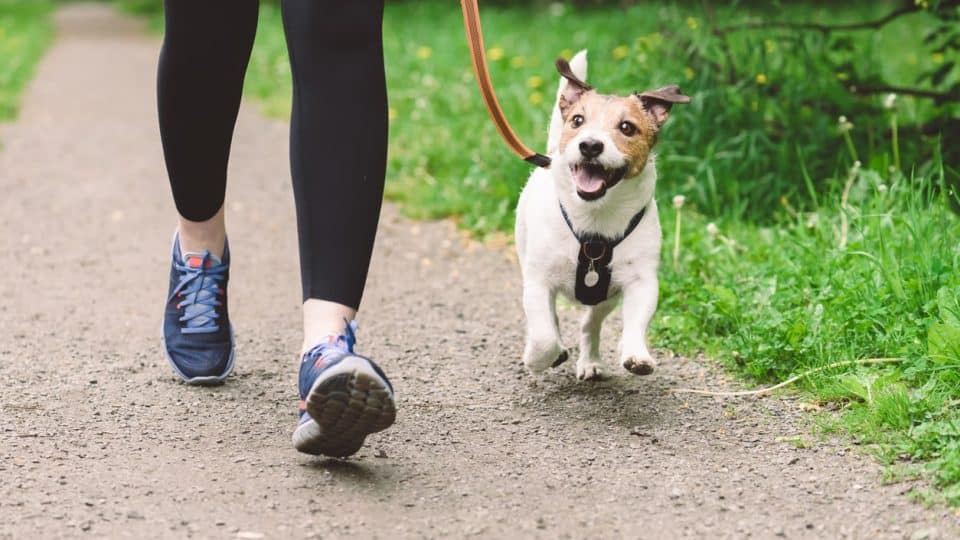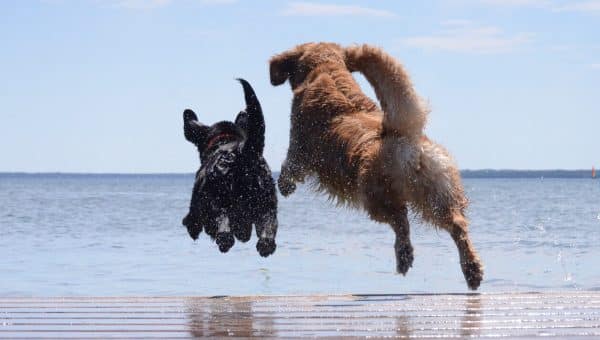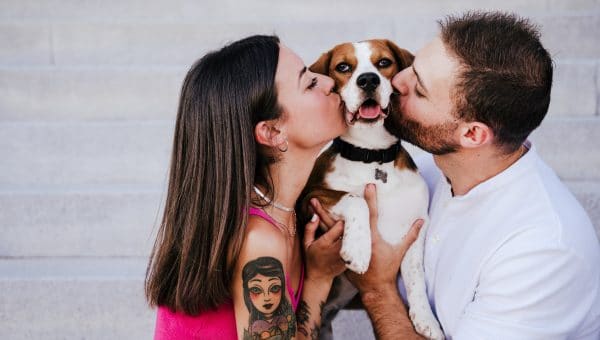- Not a substitute for professional veterinary help.
When it comes to staying fit and bonding with your dog, running is hard to beat. “Running with your dog can help them bond with you, build trust, and share a common goal,” says Dr. Tara Hansen, a veterinarian at Chewy. She adds that running keeps dogs in shape and manages their weight.
Every dog will have different limits when it comes to distance and duration. With proper training and practice, some dogs can safely run for an hour, while others will fatigue after 15 minutes. Across the board, though, pet parents should hold off on running until their pup has reached 1.5 years of age. After that, their bones should be done growing. As always, it’s a good idea to check in with your vet before jumping into a new running routine.
Which Dog Breeds Can Run?
Not every pooch is a born runner. Dr. Hansen points out that dogs with short legs, like Dachshunds and Basset Hounds, may struggle to keep pace with you. Additionally, brachycephalic breeds, like Bulldogs, won’t be good candidates for long-distance runs as they can struggle with breathing. Dr. Hansen says giant breeds prone to orthopedic problems, including Great Danes and Saint Bernards, should pass on running. You’ll also need to exercise caution with dogs who are overweight, elderly, or who have pre-existing health conditions, like joint issues, heart disease, or respiratory problems.
“Regardless of the type of dog you’re running with, it’s important to gradually build them up to running long distances to avoid injury,” says Dr. Hansen. With a little bit of practice and patience, you can both enjoy running together.
How to Begin Running with Your Dog
The best piece of advice for running with your dog: ease into it slowly. Don’t expect to tackle a marathon immediately; it takes several weeks to build up to that. This initial phase is a good time to learn your dog’s level of interest in running, too. Every dog has a unique personality, and not all dogs will love running, even super active ones. Observe your pet’s enthusiasm for running—or lack thereof. Good indicators that your dog is enjoying themselves include tail wagging and the ability to keep up.
Since the impact of running can damage developing growth plates, experts recommend against running with puppies before they’re done growing: typically around 1-1.5 years of age.
Once your pup is fully grown and you get the all-clear from your vet, you can look for these signs your dog is ready to go on full runs:
- Overall fitness: Dogs should be healthy and have sufficient stamina.
- Energy level: Naturally active dogs will make ideal running partners.
- Obedience: A well-trained dog with good leash manners will be safer on the trail.
- Familiarity with commands: Dogs should understand basic commands like heel, sit, and come before learning to run.
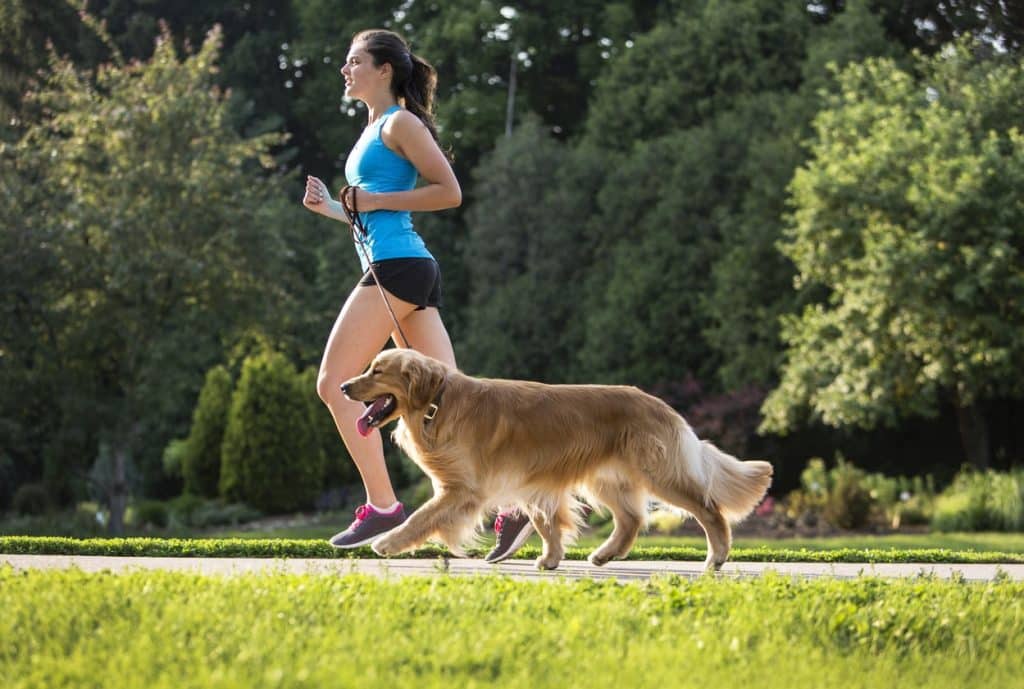
iStock/JMichl
How To Keep Your Dog Healthy On A Run
Running can do wonders for your dog’s health. However, a few precautions are necessary before embarking on any new exercise regimen.
1. Set a safe pace
You wouldn’t jump straight from the couch to a marathon—neither should your dog. It’s essential to build up stamina gradually, checking in with your dog throughout the process, says Dr. Bethany Hsia, DVM, marathon runner, and co-founder of CodaPet.
“Monitor your dog’s overall well-being, including their joints, muscles, energy levels, and recovery times,” she advises. “It is crucial to listen to your dog’s [body language] cues and make adjustments accordingly.”
Dr. Hsia offers this general leveling-up schedule for increasing your dog’s endurance. However, this will look a little different from dog to dog.
| Week 1 | Start with short walks around the block or in a park to assess your dog’s comfort level and fitness. |
| Week 2 | Increase the distance gradually by adding an extra block or extending the walk by a few minutes. |
| Week 3 | Introduce short intervals of jogging during the walks. Start with 1-2 minutes of jogging followed by a rest period of walking. Repeat this a few times during the session. |
| Week 4 | Increase the duration of jogging intervals to 3-5 minutes while maintaining rest periods in between. |
| Week 5 | Begin incorporating longer continuous jogs into the routine. Aim for a distance of 1 kilometer or approximately half a mile. |
| Week 6 and beyond | Gradually increase the distance covered during each run by approximately 10-20% per week. |
2. Check your dog’s heart rate
A normal heart rate for an adult dog is between 60 and 140 beats per minute. Smaller dogs tend to have a faster heartbeat, while bigger dogs have a slower one. Knowing your dog’s baseline is helpful for comparing their heart rate after a run. A heart that continues to beat excessively fast long after your run could be a sign your dog is overheated or dehydrated.
To check your dog’s heart rate, try the following:
- Place your hand on their chest
- Alternatively, you can detect your dog’s pulse on their femoral artery: place two fingers on the middle of their thigh where the leg joins the body
- For 15 seconds, count how many pulses you feel
- Multiply this by four to get the number of beats per minute
3. Protect your dog from environmental hazards
Dr. Hansen says pet parents need to protect their pup from potential dangers, including harsh surfaces like concrete, hot asphalt, and rocks. Additionally, they should be mindful of the sun. “Light-colored dogs are at risk for sunburn, and black dogs can overheat in intense sunlight.” Using dog-specific sunscreen is a smart safety measure.
Consider your running location, too; whereas traffic may be a concern on city runs, nature trails introduce potential encounters with wildlife, snakes, or insects.
To avoid these hazards, Dr. Hansen recommends assessing the weather before heading out and making sure to bring along any necessary items to keep your pet safe. “Make sure your dog is wearing up-to-date identification and stop every 15 minutes or so to check your dog’s feet and provide water breaks,” she says.
What Gear Do You Need to Start Running with Your Dog?
Having the right running gear can keep your dog safer and more enjoyable. Before you hit the trail, here are a few running essentials to have on hand.
Waist leash
A hands-free leash allows your body to move naturally while running. It also minimizes your risk of dropping the leash mid-run. Waist leashes feature a built-in bungee with some stretch, which allows your pup to change pace. Just remember, this type of gear may take some getting used to.
Travel bowl or water bottle
If you’ve ever tried sharing a human water bottle with your pooch, you know it’s headache-inducing. Dog-specific water bottles make it easier to transport and serve water to your dog on the go.
Visibility gear
If you’re an early-morning jogger or you like running at dusk, it’s critical to stay visible to cars. You can try a reflective leash, a reflective harness, and/or a light-up collar.
Cold weather clothes
Dr. Hsia says some dogs will benefit from wearing a coat on colder runs, depending on their breed and individual tolerance to cold. Short-haired breeds or those will low body fat may appreciate the warmth of a cozy fleece jacket. “However, it is important not to overdress them, as they still need to dissipate heat through their natural coats,” Dr. Hsia cautions. Large breeds with thick coats may overheat in an extra layer of clothing.
If you’re more concerned with rain than cold, a waterproof (or at least water-resistant) rain jacket can help make things more tolerable.
Booties
If your dog will tolerate them, booties can come in handy year-round. In the summer, they protect paw pads from blistering pavement and scorching sand. In the winter, they protect your dog’s feet from cold, ice, and salt. A protective paw wax, like Musher’s Secret, can also prevent cracking and pain.
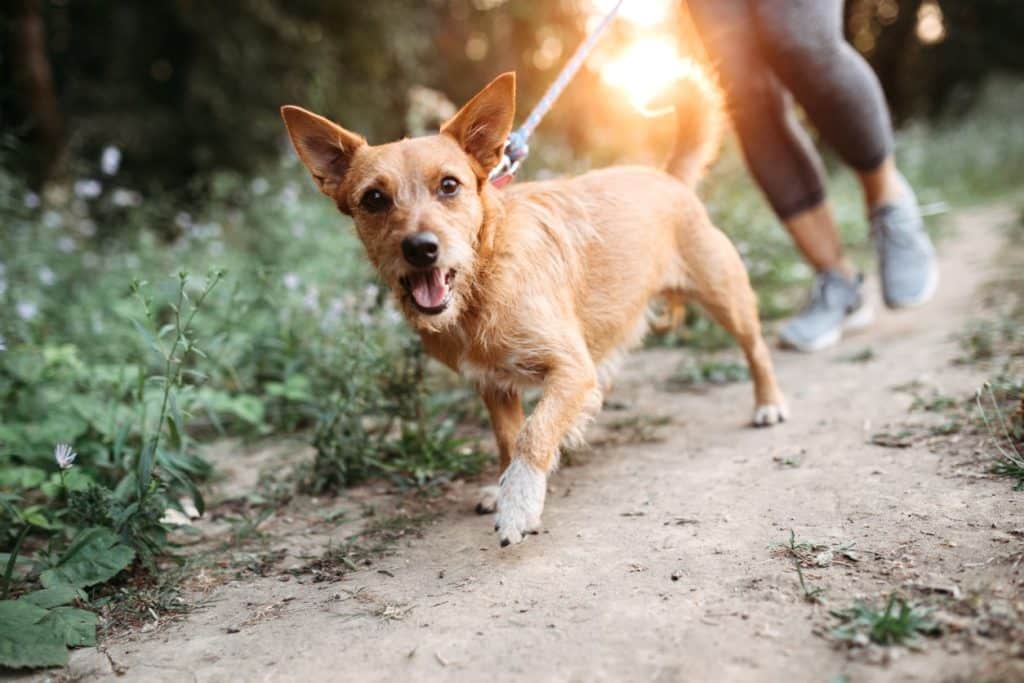
iStock/RyanJLane
Seasonal Running Guide for Your Dog
Running can be a year-round activity—but each season brings with it certain risks. As Dr. Hansen explains, dogs differ in their tolerance to extreme temps. “In general, dogs with short coats, a lean body, and longer muzzles are more tolerant of warmer temperatures,” she says. “Dogs with heavier coats and more body fat can handle cooler temperatures.” Here are some other seasonal concerns to watch for.
Running in spring
With spring comes fresh smells, warm breezes…and a surge in allergens. Pollen can cause respiratory issues or seasonal allergies in some dogs, Dr. Hsia says. It may help to give your dog a bath or at least wipe down their coat after a springtime run. It’s also essential to give your dog tick and flea prevention.
Running in summer
Summer brings hot weather—which puts dogs at risk of heatstroke or heat exhaustion. “Unlike humans, dogs are unable to regulate body temperature through sweating, so they are more prone to overheating,” Dr. Hsia explains. She advises pet parents to be mindful of signs of overheating, such as excessive panting, drooling, and lethargy.
To determine how hot is “too hot” for running with your dog, Dr. Hsia recommends looking at the heat index, which accounts for both temperature and humidity. If levels are in the caution range, she advises limiting the duration and distance of your run. “A good rule of thumb is if it’s too hot (or cold) for you outside, the same goes for your pup.”
Dr. Hansen says a dog-friendly range will usually fall between 32 and 70 degrees Fahrenheit. Since heatstroke can be life-threatening, she says it’s critical to seek shade or cooler temps indoors at the first signs (heavy breathing, incoordination, disorientation, vomiting, diarrhea, bruising on the gums or skin, or even seizures). Provide plenty of drinking water, and call your vet with any concerns.
Running in fall
In autumn, falling leaves can cover unseen hazards or debris like sticks or rocks. Wet leaves can also be slippery. In addition, shorter daylight hours make reflective gear a must. Be mindful, too, of your location, as encounters with hunting season are possible.
Running in winter
“During the winter, dogs are prone to suffer from hypothermia or frostbite if exposed to extremely low temperatures for prolonged periods,” says Dr. Hsia.
To warm your dog up after a winter run, first get them indoors. Then, Dr. Hansen says to wrap them in a blanket and gently rub their feet and ears to warm up their extremities. “Warm water bottles and rice bags placed along their trunk are also helpful but should not be placed directly against their skin,” she says.
How to Train Your Dog to Run With You
Before you get started, some basic dog training is in order. “Handlers need to start at a walk before they expect their dogs to be able to run with them,” says veterinary behaviorist and fear-free certified trainer Leslie Sinn, DVM, DACVB.
To train dogs to run in a straight line (and not underneath their handler’s feet), Dr. Sinn says pet parents should work on their “heel” command. This cue means “stay at my side,” which is the easiest position for running with a dog. A dog’s head should be at the level of your hip or knee: no further forward than that, says Dr. Sinn.
Once a dog can maintain this position, Dr. Sinn says handlers can gradually begin to increase speed. As she explains, you don’t train a dog to understand a “speed cue.” Rather, you train them to hold a position regardless of the speed you are moving. “If the dog understands that is the place they are supposed to be, they will automatically adjust their pace when you do,” says Dr. Sinn.
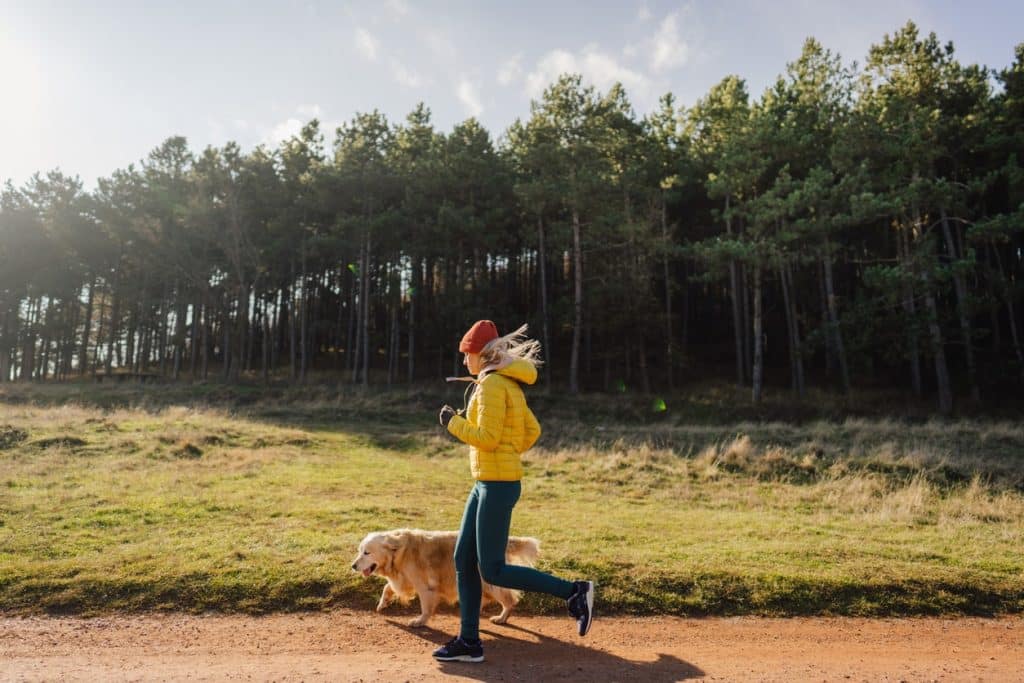
iStock/AleksandarNakic
What Limitations Does Your Dog Have When It Comes to Running?
Even the strongest athletes have their limits. Too much exercise can harm your dog’s body, says Dr. Kathryn Rosalie Dench, a veterinary surgeon and advisor for Gentle Dog Trainers. She says overexertion can lead to muscle strain, joint injuries, heatstroke, and even heart problems.
To avoid this, gradually build up your dog’s level of exercise. “Start slow and observe your dog’s response,” says Dr. Dench. “If they seem tired or show any signs of discomfort, like limping or heavy panting, it’s time to ease up.” Dr. Dench reminds us that dogs can’t verbally communicate when they’ve had enough, so it’s crucial to pay attention to their body language.
Takeaway
How fast, far, and long can a dog run? There’s no one answer to this.
Dogs differ in their running capabilities. The distance and length of time they can run will be largely dependent on their age, breed, and health status. “Small [dog] breeds may be content with shorter runs, while larger, more active breeds may have more endurance,” says Dr. Dench. Lastly, sporting and working breeds tend to be better at distance running.
